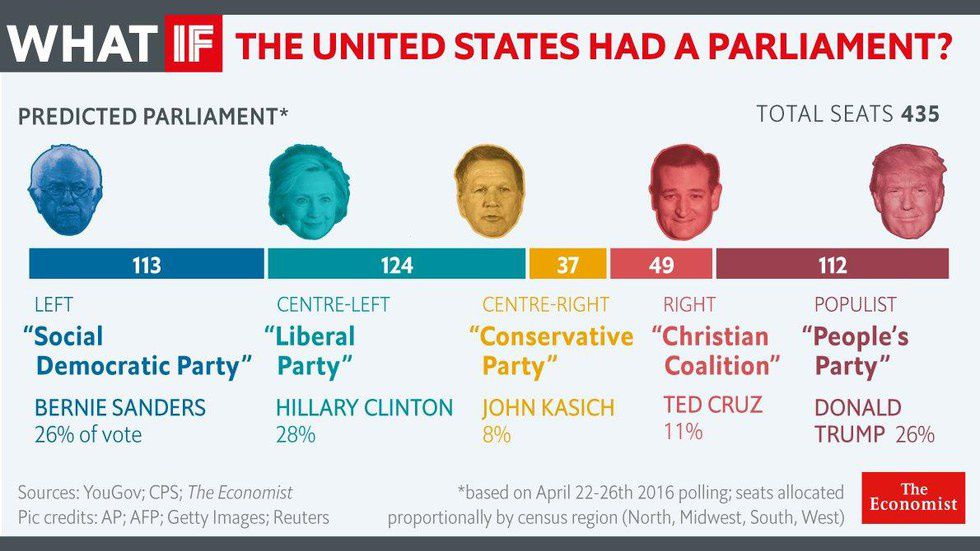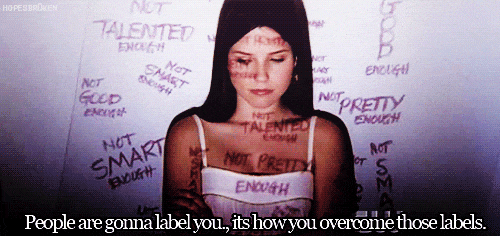The Economist last week tweeted out an infographic for how the United States House of Representatives would look if the Republican and Democratic primaries had been to elect Members of Parliament (MPs) instead of presidential nominees. The picture shows a stark contrast to what is currently going on in our political discourse.
Since Donald Trump officially became the presumptive GOP nominee, we have witnessed a very tepid response by most elected Republicans, with many walking a tight line between supporting him and endorsing him. This does not necessarily mean that the Democratic side has been any smoother. While many Democrats support their now presumptive nominee in Hillary Clinton, the insurgent Bernie Sanders has yet to leave the race, which will potentially leave some of his voters undecided on where to go for quite a while. Some may think it would be crazy for some of Sanders voters to go to Trump, but Donald has tried to and will continue trying to woo these voters, and based on the rhetoric and populist appeal of both candidates, it may not be as unlikely as many observers may think.
However, looking back at the infographic, The Economist has designed five separate parties based on how they felt each candidate appealed to voters, and showed it on the traditional left-right spectrum. Starting on the left, the Dove Whisperer Bernie Sanders represents the “Social Democratic Party,” or “Democratic Socialist” Party, as he may prefer. I am sure that this party would also encompass the members of the Congressional Progressive Caucus (CPC), as well as several other left-leaning independents. Notable Hillary Clinton follows signifying the center-left “Liberal Party,” or what I would just call the current Democratic Party. Current Ohio Governor and that guy who also ran for president, John Kasich, then shows up near the middle of the spectrum, being grouped together with the center-right “Conservative Party.” This party could be viewed mainly as having the moderate or establishment Republicans, which would include familiar faces like current Speaker of the House and part-time fitness model Paul Ryan and Marco Rubio.
The graphic continues on to what would be considered the right-wing parties. The first is led by unsettling speaker and Dr. Seuss aficionado Ted Cruz, representing the “Christian Coalition.” This group would most likely bring aboard the controversial members of the House Freedom Caucus who famously forced former Speaker of the House John Boehner to resign his post late last year. The final segment would be Trump’s populist “People’s Party,” or as I would like to call it “The Trumpist Party.” It is really hard to gauge what sorts of people would be members of this party, would you include someone like Trump’s punching-bag Chris Christie, or controversial figures like Sheriff Joe Arpaio. Regardless, I could still see this party holding a place in a potential United States Parliamentary system, much like the UKIP in the United Kingdom, who recently won a victory after the United Kingdom shockingly left the European Union on Thursday.
Still, having a Parliamentary system in the United States is unlikely to happen anytime soon. While there has been a lot of calls for a viable third-party candidate in the 2016 election, with the names of Green Party candidate Jill Stein and Libertarian candidate Gary Johnson being thrown around, it remains unlikely that either can even muster the 15 percent needed to even get on a Presidential Debate stage before Election Day. While there have been fairly successful third-party runs, with some collecting electoral votes, they typically end up playing a spoiler role to a Democratic or Republican candidate, whether it be Ross Perot in 1992 or Ralph Nader in 2000.
However, now that the Presidential Primaries are over, voters need to focus on races up and down the ballot. There is widespread disapproval of Congress and with 469 Congressional seats up for grabs in November, so it is time to let your voice be heard. If you are a disappointed Sanders supporter, find out candidates that share similar values to Bernie or individuals that he has endorsed and support them. If you are a member of the #NeverTrump movement, support candidates in congressional races that will embrace your ideals or maybe even third-party presidential candidates.
For far too long, many Americans have not paid close attention to political discourse in this country, but maybe with the influx of new voters in 2016, we will see a renewed interest. If the nation truly tunes in, the people will regain much of the power in our nation.





















 sunrise
StableDiffusion
sunrise
StableDiffusion
 bonfire friends
StableDiffusion
bonfire friends
StableDiffusion
 sadness
StableDiffusion
sadness
StableDiffusion

 purple skies
StableDiffusion
purple skies
StableDiffusion

 true love
StableDiffusion
true love
StableDiffusion
 My Cheerleader
StableDiffusion
My Cheerleader
StableDiffusion
 womans transformation to happiness and love
StableDiffusion
womans transformation to happiness and love
StableDiffusion
 future life together of adventures
StableDiffusion
future life together of adventures
StableDiffusion





















